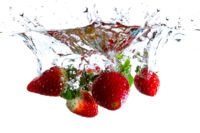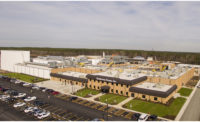A custom oxygen booster system from Linde LLC, known as the SOLVOX oxygenation system, proved effective in dramatically lowering biochemical oxygen demand (BOD) for an on-site wastewater treatment facility for Koch Foods’ poultry deboning plant in Morristown, Tenn.
The SOLVOX system was designed and retrofitted for an existing 225,000-gallon aerobic equalization tank feeding a dissolved air flotation (DAF) units, which are widely used to separate 95-99% of fats, oils and greases and total suspended solids in organic wastewater treatment plants. Yet, they are less effective in lowering BOD, which is sometimes necessary to reduce odors and meet municipal discharge requirements.
Key to success of the new system was control of soluble BOD (sBODs).The poultry processing plant produces more than 70 million pounds of cut wings and boneless chicken nuggets, tenders and breasts every year. While aeration systems may follow DAF pre-treatment and are almost always part of publicly operated wastewater treatment facilities, Larry Moore, professional engineer and professor of environmental engineering at the University of Memphis and consultant for the Tennessee Manufacturing Extension Program (TMEP), recommended oxygenating the wastewater before the DAF unit. Moore analyzed the wastewater treatment complex on behalf of the City of Morristown and TMEP and reviewed BOD treatment options. TMEP does not endorse or warranty any specific method, product, process or service. It is an industrial assistance program designed to help industries make sound decisions regarding environmental management.
“Oxygenation before DAF may be counterintuitive since water can only hold so much oxygen. But, Koch Foods’ wastewater was well below oxygen saturation concentrations because of the level of soluble BOD that remained after screening solids. The presence of the equalization tank before the DAF unit made O2 pre-treatment possible and cost effective,” he says.
Barry Calfee, certified environmental and safety compliance officer at Koch Foods, Park Ridge, Ill., contacted Linde, Murray Hill, N.J. The Linde team estimated that costs for the proposed SOLVOX system would be about as low as an acid treatment system, yet would also offer significant environmental advantages.
“Sustainability is very important to Koch Foods as a leader in the food industry and a positive force in our local community. The Linde SOLVOX oxygenation system exceeded our expectations,” says Calfee.
Dramatic drop in biochemical oxygen demand
In the weeks after the SOLVOX system start-up, effluent BOD5 levels fell on the order of 90%. Even in cold weather, the system operates well within the anticipated reduction target of 50% BOD removal. Mid-November to mid-February realized an average effluent BOD5 reduction of 63.9% compared to the pre-start-up period.
The Linde solution for Koch Foods includes a 6,000-gallon liquid oxygen tank with vaporizer and control system. The SOLVOX control system delivers O2 through a gas sparger that feeds the oxygen-enriched water into a custom injection header inside the bottom of the equalization tank. Wastewater in the equalization tank is continuously recirculated back through the sparger. In addition to creating a homogeneous mixture of wastewater, the equalization tank also equalizes the flow to the flocculation tubes, which are part of the DAF process.
With the SOLVOX system in place, colloidal and soluble BOD is converted in the equalization tank in one of two ways: 1) Some is oxidized to carbon dioxide and water, which creates energy for the biomass, and 2) some is converted into biomass, which is easily skimmed off by the DAF unit.
Linde pure oxygen injection and O2 diffusion systems can boost dissolved oxygen levels more efficiently than aeration systems, which require energy-intensive compressors. The Linde SOLVOX oxygenation system offers several different types of oxygen delivery and control systems. Linde engineers help to determine the optimal solution for oxygen injection. For example, oxygen can be injected directly into pipes using customized spargers, diffused into a treatment tank using special oxygen diffusion mats or nozzles, or injected into a lagoon through high-velocity jets.
When dissolved air flotation needs a boost
For separating solids, DAF units often use a coagulant and flocculent (polymer) ahead of the flotation unit. Yet, there are limits to these pre-treatments, especially when organic solid loadings are high or hydraulic pressure dips. DAF pre-treatment chemicals help reduce organic solids but have far less impact on sBOD, which requires improved aerobic digestion. In general, poor aeration promotes anaerobic decay, which can lead to foul odors and complaints from the community. In addition, excursions above BOD discharge targets can result in special fees or assessments from wastewater treatment authorities.
Large-scale DAF tanks can measure 40 feet long or more, and are often used in conjunction with buffering tanks, lagoons or activated sludge systems to improve clarification of organic solids. An industrial DAF unit is often the last line of control prior to discharge into a municipal sewer system. Food industry segments that rely on DAF for organic wastewater treatment include meat, poultry and seafood, dairy, frozen foods and prepared foods.
Some DAF units can readily handle TSS concentrations in excess of 10,000 mg/L. But, even large-scale treatment systems can exceed BOD processing capacity when operations expand. This was the case for the Koch Foods plant, which had nearly doubled poultry production volumes over a 5-year period before installing the newSOLVOX oxygenation system. Total process wastewater flow rate at the plant remained about the same, averaging about 130,000 gpd, but with increasing volumes of TSS, FOG and BOD.
From industrial wastewater to municipal water treatment, bulk oxygen and oxygenation systems from Linde LLC can address a range of environmental control issues. Beyond BOD and odor control, Linde pure oxygen systems can boost the efficiency of aeration water treatment systems or completely replace them. Also for water treatment, Linde supplies bulk gases for ozonation systems, which can help control waterborne bacteria and limit the use of chlorine, and supplies bulk liquid carbon dioxide, which can reduce the pH of high alkalinity wastewater without hazardous mineral acids.



